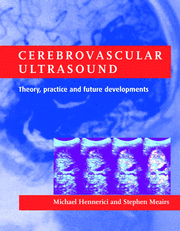Book contents
- Frontmatter
- Dedication
- Contents
- List of contributors
- Preface
- PART I ULTRASOUND PHYSICS, TECHNOLOGY AND HEMODYNAMICS
- 1 Introduction to Doppler ultrasound
- 2 Doppler technology
- 3 Principles and models of hemodynamics
- 4 Computational principles and models of hemodynamics
- 5 Flow patterns and arterial wall dynamics
- 6 Duplex and colour flow imaging
- 7 Misconceptions and artefacts in ultrasound examination of the carotid arteries
- PART II CLINICAL CEREBROVASCULAR ULTRASOUND
- PART III NEW AND FUTURE DEVELOPMENTS
- Index
2 - Doppler technology
from PART I - ULTRASOUND PHYSICS, TECHNOLOGY AND HEMODYNAMICS
Published online by Cambridge University Press: 05 July 2014
- Frontmatter
- Dedication
- Contents
- List of contributors
- Preface
- PART I ULTRASOUND PHYSICS, TECHNOLOGY AND HEMODYNAMICS
- 1 Introduction to Doppler ultrasound
- 2 Doppler technology
- 3 Principles and models of hemodynamics
- 4 Computational principles and models of hemodynamics
- 5 Flow patterns and arterial wall dynamics
- 6 Duplex and colour flow imaging
- 7 Misconceptions and artefacts in ultrasound examination of the carotid arteries
- PART II CLINICAL CEREBROVASCULAR ULTRASOUND
- PART III NEW AND FUTURE DEVELOPMENTS
- Index
Summary
Introduction
The use of ultrasonic waves for studying the human circulation was initiated in the late 1950s and early 1960s by Satomura (1957), Franklin et al. (1961) and Pourcelot (Georges et al., 1965). These pioneering works were based on the Doppler effect and led to the development of the first continuous-wave Doppler velocimeters. These systems were non-directional and used perivascular probes during acute and chronic surgical procedures. For the transcutaneous approach it was necessary to develop directional systems, which were first designed by MacLeod (1967) and Pourcelot (1969) and were based on quadrature phase detection of complex Doppler signals.
The first pulsed Doppler systems were developed almost simultaneously by Baker (1970), Peronneau and Leger (1969) and Wells (1969). These new velocimeters had the major advantage over CW Doppler to be range sensitive, but they were difficult to apply in routine without the support of an imaging technique (Duplex B-Doppler systems).
The first trials for real-time imaging the blood circulation by the Doppler technique (now called colour-coded Doppler), were successful in 1977 and the first commercial machine was on the market in 1984 (Aloka). Since these dates, numerous improvements have been made for the simultaneous display of structures and blood flow: colour velocity imaging, power Doppler imaging, Doppler tissue imaging, non-linear imaging (harmonic imaging, pulse inversion imaging), 3D colour-coded display of vascular structures, etc.
Continuous-wave Doppler
By insonating tissues where blood is flowing, and then studying the received signal, a non-invasive measurement of the blood velocity can be made.
- Type
- Chapter
- Information
- Cerebrovascular UltrasoundTheory, Practice and Future Developments, pp. 16 - 24Publisher: Cambridge University PressPrint publication year: 2001



